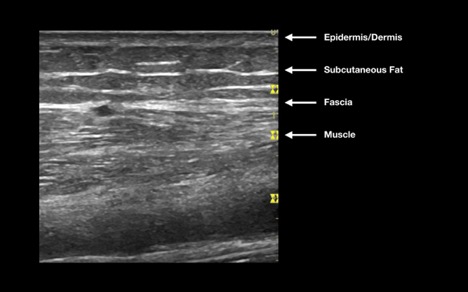What is normal?
Normal skin has a highly organized structure. The most superficial structures are the epidermis and dermis, which are often difficult to distinguish from each other. They will appear as a hyperechoic line immediately superficial to the globules of relatively hypoechoic subcutaneous fat. Within the hypodermis you may visualize blood vessels, nerves, and lymph nodes of varying echogenicity. Deep to the subcutaneous fat, the fascial layer appears as a hyperechoic layer immediately superficial to the more organized hypoechoic and striated muscle fibers. Lastly, depending of the depth setting, a hyperechoic and smooth bone cortex may be visualized.
Figure 1: Anatomy of Normal Skin

Courtesy of Matt Tabbut @ mtabbut
Video 2: Video illustrating normal skin and soft tissue
Lymph nodes can often mimic abscesses as they can be well circumscribed with hypoechoic central areas. In children, in particular reactive lymph nodes are often clinically challenging to distinguish from abscess. However, sonographically lymph nodes, are more oval and organized in shape than abscesses. Classically, lymph nodes will display a central stalk or hilum that is hyperechoic (bright white). At the base of the stalk, there is accompanying vasculature which will demonstrate flow when color Doppler is applied. Lymph nodes should not have surrounding signs of cellulitis or cobblestoning. Lastly, there is less posterior acoustic enhancement in lymph nodes than in abscesses.
Figure 2: Sonography of a normal lymph node

Video 3: Lymph node video
